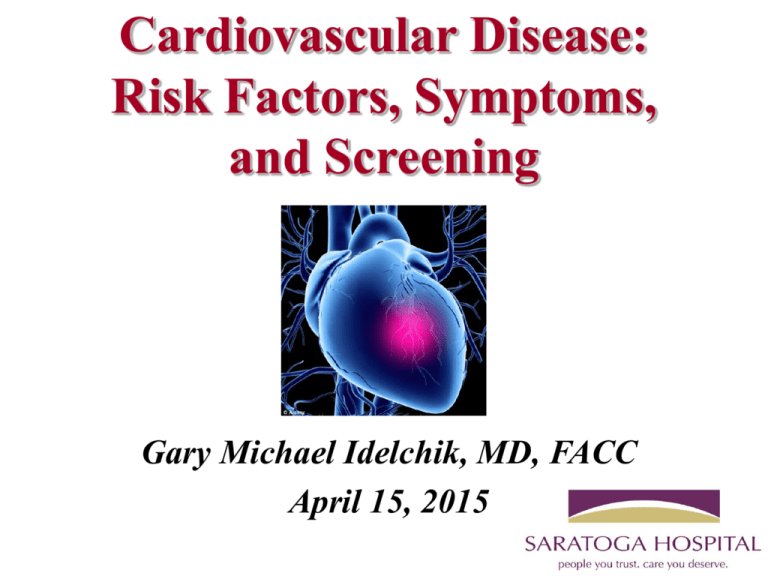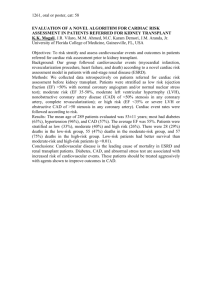Risk Factors, Symptoms, and Screening
advertisement

Cardiovascular Disease: Risk Factors, Symptoms, and Screening Gary Michael Idelchik, MD, FACC April 15, 2015 Disclosures I have nothing to disclose. Outline What is/are… • What is Cardiovascular Disease and its manifestations? – What is Coronary Artery Disease (CAD)? – What is Peripheral Artery Disease (PAD)? – What is Cerebrovascular Disease (CVD)? • Acute Coronary Syndromes (ACS)? • ST-segment Elevation Myocardial Infarction (STEMI)? • Risk factors? • Screenings? • What are the therapies for care and why? • What role does Percutaneous Coronary Intervention (PCI) play? • Additional Questions Needed Answering? Cost of Coronary Artery Disease and Cardiovascular Disease Historically, • • • • 17,600,000 Americans adults have a history of CAD. 8,500,000 American adults have a history of MI. 400,000 deaths annually (approx. 1 of every 6 deaths). 300,000 die from their initial Acute Coronary Syndrome (ACS) event. Today… • • • • 785,000 will have their initial cardiac event. 470,000 will have a recurrent event. 195,000 will have a silent cardiac event. Estimated direct and indirect costs for Cardiovascular Disease – $503.2 billion. • Estimated direct and indirect costs for Coronary Artery Disease – $177.1 billion. AHA Heart Disease and Stroke Statistics 2010 Update. Circulation 2010;121:e41-e215. Cardiovascular Disease Cerebrovascular Disease (CVD) Peripheral Artery Disease (PAD) Coronary Artery Disease (CAD) Pathophysiology of Cardiovascular Disease Foam Cells Fatty Streak Intermediate TCFA/Fibrous Lesion Rupture Lesion Atheroma Plaque Endothelial Dysfunction Atherosclerotic Burden Adapted from Pepine CJ. Am J Cardiol. 1998;82(suppl 104). Heart Attack Heart Attack Symptoms - MEN Chest pain Discomfort in other areas of the upper body • • • One or both arms Back, neck or jaw Stomach Shortness of breath Other signs • • • • Cold sweat Nausea Lightheadedness Fatigue Heart Attack Symptoms - WOMEN As with men, chest pain or discomfort More likely- other symptoms: • • • • • • • • Shortness of breath Nausea/vomiting Back or jaw pain Not feeling right Fatigue Palpitations Musculoskeletal complaints Hot flashes Pathophysiology of ACS/STEMI ‘Heart Attacks’ • 1980 DeWood et al. provided definitive Angiographic and Histologic Evidence that intra-arterial thrombosis was the inciting event for STEMI, resulting in: – Treatment with Antiplatelet and Antithrombotic therapies. – The ‘Open Artery’ Theory, for AMI and patients with hemodynamically significant CAD. STEMI and ACS STEMI Presumed prognosis: very high risk of in-hospital death Treatment goal: prevent death by restoring coronary blood flow Fibrinolytic therapy Direct PCI NSTEMI/Unstable Angina Presumed prognosis: low risk of in-hospital death, unless MI develops Treatment goal: stabilize with aspirin heparin +/-GIIb/IIIa & monitor for MI development + Cardiac enzymes Scheduled PCI – Cardiac Enzymes Highrisk features Low risk features Manage medically The Continuum Unstable Angina Non-occlusive thrombus Non-specific EKG Normal cardiac enzymes NSTEMI Occluding thrombus sufficient to cause tissue damage & mild myocardial necrosis ST depression +/T wave inversion on EKG Elevated cardiac enzymes STEMI Complete thrombus occlusion ST elevations on EKG or new LBBB Elevated cardiac enzymes More severe symptoms Percutaneous Coronary Intervention (PCI) for ACS and STEMI GE Cardiac Catheterization Lab Unstable Angina PCI NSTEMI PCI STEMI PCI TIME IS MUSCLE • Reduce patient symptoms • Decrease amount of myocardial necrosis • Preserve heart function • Prevent major adverse cardiac events • Treat life threatening complications Stroke aka ‘Brain Attack’ Carotid Artery Disease • Stroke is the third leading cause of death in the U.S., accounting for 164,000 deaths/year. • Approx. 1 million stroke-related events per year. – 500,000 New strokes – 200,000 Recurrent strokes – 240,000 TIAs. • Carotid Occlusive Disease accounts for 5% to 12% of new strokes • Screening with Carotid Arterial Duplex Stroke Symptoms – F.A.S.T. • • • • Loss of vision from one or both eyes Sudden onset of severe headache Loss of coordination, balance Sudden onset of confusion Carotid Artery Disease Carotid Artery Disease Peripheral Artery Disease Peripheral Artery Disease (PAD) ♥ PAD is a narrowing of the peripheral arteries, most common in the arteries of the pelvis and legs ♥ The most common symptoms of PAD are: • Cramping • Pain or tiredness in the leg or hip muscles while walking or climbing stairs PAD PAD Screening ♥ Two-fold Purpose - Preventing progression of asymptomatic to symptomatic PAD - Detect high-risk CVD patients for risk-reduction ♥ Ankle-Brachial Index (ABI) - Ratio of blood pressure in arm and ankle Abdominal Aorta Aneurysm (AAA) • Localized Dilation of the Aorta with an Increase of > 50% of the normal diameter • Varies by age, gender and body surface area. • Diagnosed if the aortic diameter is > 3 cm. Abdominal Aorta Aneurysm (AAA) • Affects 6-9% of patients over 65 years of age. – 1.7% of Women and 5% of Men have an AAA > 3 cm. – Incidence Increases by 6% per decade thereafter. • Estimated > 1.5 Million Patients in the U.S. have an AAA. • Cause Approx. 15, 000 Unexpected Deaths Per Year. • > 2.7 Million Patients by 2025. AAA Size Age Men Women 45 - 54 1.3% 0% 75 - 84 12.5% 5.2% 2.9 - 4.9 cm Risk of AAA Rupture Related to Size 30% 26% 25% Annual Rupture… 20% 15% 11% 10% 5% 0% 0% 1% < 4.0 cm 4.0 - 4.9 cm 5.0 - 5.9 cm 6.0 - 6.9 cm AAA Screening SAAAVE ACT • One-time AAA screening as part of a ‘Welcome to Medicare’ physical for men. • Eligibility limited to males turning 65 • History of smoking 100 cigarettes or more. • Family history of AAA (men and women). Cardiovascular Care Cardiac Screening – See your Doctor • Know your personal and family history • Routine medical appointments • Talk to your health care provider • Know your medications and drug allergies • Take charge of your health • Get appropriate screening High-risk for future cardiovascular disease? High-risk for future cardiovascular disease? High-risk for future cardiovascular disease? Cardiovascular Disease Risk Factors History of CAD/PAD Male Sex History of TIA/CVA Smoking Hypertension Diabetes Mellitus Dyslipidemia Family History - event in first degree relative > 55 male, > 65 female – Low HDL < 40 – Elevated LDL / TG Chronic Kidney Disease Obesity Lack of regular physical activity Diet poor in fruits, vegetables, and fiber Age > 45 male, > 55 female Risk Factors that Can’t Be Changed ♥ ♥ ♥ ♥ ♥ Age Gender: Male Heredity – Family History Race Previous CAD, PVD or CVA Smoking, Smoking, …and Smoking Diet Western Lifestyle Treatments and Therapy Cardiovascular Medical Therapy Antiplatelet agents – Aspirin – Brilinta/Plavix/Effient Lipid lowering agent – High-dose Statin (Lipitor, Crestor) Antihypertensive agent – Beta blocker – ACE-I/ARB – Aldactone (as appropriate) Appropriate therapy for risk factors Cardiovascular Care Blood Pressure – Goal < 135/85 – Maximize use of beta-blockers and ACE-I Lipids – LDL < 100 (70) ; TG < 200 – Maximize use of statins; consider fibrates/niacin first line for TG > 500; consider omega-3 fatty acids, CoEnzyme Q10 Diabetes – HbA1c < 7% Cardiovascular Care Smoking cessation – Cessation-class, medications, counseling Physical activity – Goal 30 - 60 minutes daily – Risk assessment prior to initiation Diet – DASH diet, Mediterranean diet, fiber, omega-3 fatty acids – <7% total calories from saturated fats Cardiovascular Diet Thank You








